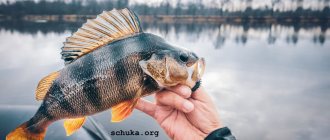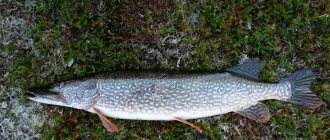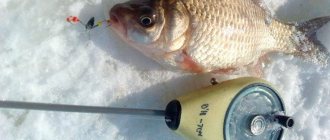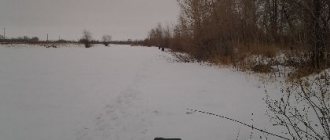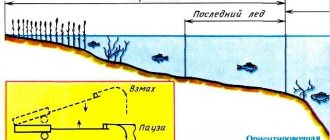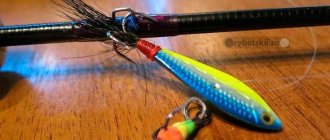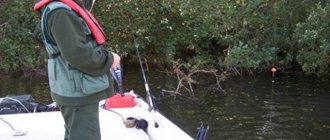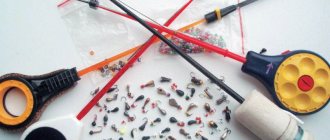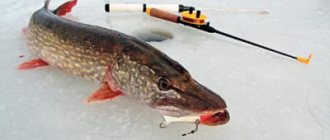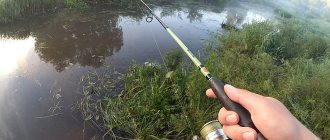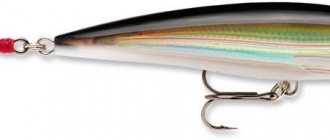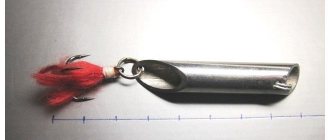Behavior and biting of perch in February
February is a difficult period for representatives of the ichthyofauna, including perch. But unlike the others, the striped predator retains a certain activity; it is much easier to interest it by offering interesting bait. Therefore, perch fishing is popular among anglers in February.
At the beginning of the month, the predator is weakly active, and at the end of February, perch fishing becomes more active due to thaws.
Thaw affects the bite
In the first days of the month, when the ice is still strong, due to the low concentration of oxygen, the fish become lethargic, passive, and rarely leave their wintering pits. This is especially pronounced in small reservoirs and lakes. Locations of perch can be identified near warm springs and tributaries. The predator avoids shallow areas of the reservoir with muddy water.
In search of food, it moves more actively in rivers, where water flows circulate better. Fishing will also be effective in reservoirs with great depths. It is more likely to catch a large perch in mid-to-late February, when the ice begins to “weaken.” It is much easier to search for it; it does not concentrate at one point, but is scattered throughout the entire reservoir.
In February, perch is most active on large rivers with strong undercurrents. Classic fishing takes place using jig tackle and the principle of trolling.
Going out hunting when weather conditions change is not very effective; perch reacts poorly to any type of bait. The mining activity will be during a stable period. The striped predator feels normal in light frosts down to -10 °C, with stable pressure and a light breeze.
What weather is suitable for fishing in February?
It will be cool in February
when the weather remains stable for 2-3 days. The fish are especially active when the weather is warm, as for February, not lower than -10° C. It is very good for fishing if there was no precipitation, which means there were no pressure surges. This weather in February is the most suitable for fishing.
The bite will be poor or completely absent
, if the pressure has changed by at least 5 mm Hg in any direction, with changing weather conditions, with frequently changing wind direction. In general, the exact opposite of good weather for fishing.
Where to look for perch in February
You can expect a perch bite in February in any horizon, except for places that are too deep and areas with strong currents. At the beginning of the month, permanent winter camp sites for the predator will be promising, and at the end, shallow water areas should be fished.
Look for perch on the river:
- in places with weak currents;
- in the creeks;
- on the bays;
- in thickets of coastal vegetation.
In reservoirs, fishing success is possible in the flooded floodplain. The riverbed attracts little perch; there is not only great depth and few places for shelter, but also poor visibility. Flooded river valleys benefit greatly due to the abundance of food supply and secluded places; the striped predator is found here much more often. It is attracted to places near flooded barges and concrete structures. Good results are observed at the pier and the edge of the embankment.
You can catch perch in February both on the lake and on small rivers. If the lake is deep-water, then the perch disperses throughout the reservoir . In small water areas, areas with shallow depths, up to 2-3 meters, and thickets will work. On small rivers it is better to hunt in the deepest areas, under overhanging trees and bushes. Returns, edges, and exits from pits will also be promising. Perch bites are also possible on peat bogs, where it attracts anglers with its size and bright color. If you catch a small perch, it will be bait for pike.
Read more about catching perch in the wilderness.
Fishing place
Accordingly, at the beginning of the month, perch is caught in permanent winter camp sites. Closer to spring - in shallower places near the wintering area (of course, this is true for relatively warm regions). The perch bite in February is unstable and may stop altogether. For an angler, the main thing is to find a fish site; you can get a striped fish to bite even in the absence of activity. Where to look for perch in February? Typical winter mooring sites in reservoirs and lakes:
- Deep water areas with hard ground and underwater roughness;
- Banks and hills among the depths;
- Slopes, edges, flooded channels, deep-sea snags;
- Rocky spits, boulders, sandy slopes under water.
Perch will always stand where it is warmer (at least 4 degrees) and there is more oxygen (near springs). You should look for perch in February on a large river at various levels of stepped edges, but not on the current itself, but somewhere nearby - on the return stream or the border of the direct and reverse streams.
Fishing for perch in February on ponds and small lakes often does not bring results. In such small bodies of water there is almost always a lack of oxygen. The striped predator falls into a stupor in such places (unless these are oxygen-saturated natural lakes with springs and an abundance of food supply).
In the coastal part, among the abundance of last year's vegetation, you can almost always find small stick bass, which after the first year of life remains to winter there. The majority of striped predators do not like silt, rotting remains of plants and mud - they avoid such places in winter. In the old days, when looking for perch, anglers poked poles into the holes to check whether it was solid or muddy. And if the stick fell through, they didn’t even throw the tackle, but looked further. Nowadays, an angler can perform this maneuver using a heavy spoon sinker and rope.
Choosing the best bait
Among the catchable baits for February perch are:
- maggot;
- larvae;
- worms;
- bloodworm;
- pieces of meat/fish fillet;
- chicken/fish offal.
Perch reacts better to live bait caught from the reservoir in which hunting is planned.
It is often possible to attract the attention of a striped predator using a jig with bait. Models with body size up to 4 mm work great. Jigs have proven themselves well when catching passive fish.
Perch bites better in February on bright jigs
Improve the bait using rings made of colored insulation and red woolen threads. Lead models are painted red (tip) and black (shank of the hook). For greater efficiency, bloodworms are attached to the jig. For perch, you should choose a pellet or a drop.
In winter, the models of spinners with a size of 2–5 cm are catchy. It is better to use a matte color; effective options would be spinners in black, copper, as well as in gold and silver. A pendant on a hook works as a provoking factor.
On the jig
This method of fishing in winter is quite common.
When fishing with bait using a jig, you need to lower the nozzle to the bottom, pausing at a distance of several centimeters and swaying. Having raised the bait from the ground by about fifty centimeters, it must be lowered again. The jig and bloodworm should move along the bottom, while making slight rises. In this case, all movements of the fisherman must be very smooth. Each ice fishing enthusiast adheres to his own individual tactics, which he acquires with certain skills and experience. With thoughtful tactics combined with a good choice of location, perch fishing in February will be quite productive. When fishing using this method, you need to use a thinner line and choose smaller baits. The best jig for perch is a “larva”, “drop” or “pellet”, and the nod should be very sensitive.
February fishing tactics
To make perch fishing in February exciting and productive, use the tactics of circular fishing of holes. It is recommended to make 5–20 holes in the ice and go around each one in a circle. This technique involves fishing from the first to the last hole, then entering the second and subsequent rounds. If there are no bites or there are few of them, then the location is changed.
Another option for hunting a striped predator in February is to fish several holes and then move to another territory. Those points that have already been worked out are no longer taken into development.
Try to fish most of the lake or river
If the perch does not respond to the offered bait within 5 minutes, then it is better to change the fishing point. Only with an active search will the chances of catching a striped predator be high.
When using jigs, spinners and balancers in February, you should choose a standard wiring technique. It is better to serve the bait smoothly, leisurely, without sudden movements .
Technique
Fishing for perch in February with a balance beam works better with a fishing rod that has a forked tip. In this case, the fishing line is easily wound around the fork. The angler needs to slowly, smoothly twitch the fishing rod so that the movements of the spoon resemble a fine trembling. The fishing should continue, calmly lowering the fishing line until the bait touches the bottom and raises a cloudy cloud. Only after this can it be lifted upward. Large winter perch, as a rule, do not bite right away. Therefore, sitting at the same hole, an angler can wait quite a long time. After catching the first prey, the nozzle must be lowered again to its previous depth. If a large fish breaks away, then there is no hope for further biting: it will stop immediately.
What to catch perch in February
To catch a striped predator use:
- winter fishing rod when trolling using the vertical method;
- a fishing rod for jig hunting with a guard;
- the usual version of winter float gear.
It is good to use a small reelless fishing rod for February perch. The whip on the predator is made elastic so that there is proper shock absorption when hooking.
Attachment jigs
You should catch perch in February with a jig using a small winter fishing rod equipped with a signaling device such as a guard or a nod. The bait itself is a small hook, which is soldered into a metal alloy of a drop-shaped, round or other shape, equipped with a hole for tying a fishing line.
In order for a jig to attract perch, it must play, creating short, high-frequency vibrations. You can move the bait both up and down, taking pauses between these manipulations.
Jig technique:
- The bait with bloodworm bait is first immersed to the bottom, then raised 2 cm from it, and lifted. Pauses are made every 5 cm, accompanied by a smooth swing of the jig. When the bait is 60 cm from the bottom surface, the rise is stopped and it is lowered again.
- Having lowered the jig to the bottom, make small lifts from the bottom (1 cm). This way you can get the bait to move. Every 4 such cycles, a stop for 6 seconds is required, while the jig is either at the bottom or near it. There is no need to make any sudden movements here, everything is done smoothly.
It’s not for nothing that a baited jig is considered one of the most popular tackles for perch. It is often used in competitions. It catches both small and large predators. Efficient models made of tungsten. Despite their size, they are capable of fishing to depths of up to 8 meters. The fishing line used for it is 0.1-0.12 mm thick.
Nozzleless
Baitless fishing also brings results. Unlike attachment jigs, they are heavier. They can be used without a nozzle or using spongy flavored rubber or edible silicone. Catchable, dark, small-sized mothless moths. The color of the beads that are attached to the hook is selected by sampling, experimenting with shades.
The reelless devil behaves excellently on perch in February. Due to its heavy weight, this lead invention with a soldered hook has sufficient stability when playing at a depth of 2–3 meters.
Fishing in February
Perch.
Perch is not as sensitive to cold as other fish. Yes, of course, its bite also worsens in severe frosts and generally with the arrival of winter cold. But, nevertheless, perch does not stop being caught. In February, perch lives in areas of the reservoir where the water is saturated with oxygen. These can be areas with a current, near last year’s vegetation and, of course, in your favorite snags.
Roach.
Roach is another popular object of winter fishing; it is also caught in February. Roach is very sensitive to pressure changes, so the most successful days for catching it will be those during which the atmospheric pressure remains stable.
They mainly catch roach using a jig. Lead, copper and brass jigs, as well as green jigs and jigs of various dark colors are considered the most catchy.
Bream.
Fishing for bream in February is never easy. Usually it consists of an active search for fish and ends in success only if you are successful in this search. More
Anglers who already know the body of water have a better chance of success. If the reservoir is unfamiliar to you, you should quickly learn the habits of the bream in it.
It is almost impossible to determine promising places for catching bream. Bream moves around the reservoir throughout February, and only observing its behavior will help you find out where it might be now. For example, in the morning it can be caught in deep holes, and in the afternoon on the edge. Or vice versa. In each body of water, the behavior of bream is different, so before you find out what bream prefers here and now, you should spend time studying its behavior.
The following are excellent baits for catching bream in February: bloodworms, worms, maggots, bark beetles, dough, bread, mastyrka, cake. The use of bait is also very important. If you have not guessed the location of the bream, then it will not help much, but if you have drilled holes in the immediate vicinity of its camp, then it can very well activate its bite and concentrate the school at your bait.
Burbot.
Burbot is a unique fish. Unlike other fish, which lose activity with cold weather, burbot becomes more active the more severe the weather and frosts. February not only will not affect the activity of burbot, but, on the contrary, will increase its activity.
Burbot becomes active in the evening, comes out of its hiding places and heads to the shore in search of food. Everything he finds on his way is successfully eaten. The most common method of catching burbot in February is. In this case, a bunch of worms, live bait or pieces of fish are suitable as bait.
Catching burbot with jigs and spoons is also quite successful, you just need something more durable. Naturally, both the jig and the spinner for catching burbot will need to be larger than for perch, because burbot reaches a respectable size and can weigh up to 15 kg.
Baits and groundbait
For perch in winter, using bait can be effective. A predator will be intrigued if the jig's hook is embedded with baits such as maggots or bloodworms, as well as fresh pieces of pork or dung worms. No less important is bait for perch in winter. It is more advisable to use the same bloodworms or worms. This fish, like any other, is always in search of food. Therefore, to attract him, it makes complete sense to use bait. Unlike those mixtures that are used for peaceful species, for catching perch you almost always need to choose only a composition that is of animal origin. More often than others, the main component of bait for perch is bloodworms - both small and large. You can attract fish mixed with pieces of live bait and chopped worms. Perch, as a rule, reacts immediately to such complementary feeding.
Perch fishing in January - February
Every day it becomes colder, the thickness of the ice increases. In particularly severe winters it reaches a meter thick, and sometimes more. The fish are inactive, they have finally established themselves in winter stops - these are primarily the deepest places of lakes, rivers and reservoirs.
In the middle of winter, I had the opportunity to catch perch on Lake Komsomolskoye from almost twenty-five meters deep. (The pressure in such pits is so high that when a fish is quickly fished out, its insides come out due to a sharp pressure drop). Perch also likes to spend the winter in places where rivers flow (provided, of course, there is sufficient depth) into large bodies of water.
Considering that in the middle of winter perch and almost all fish are sluggish, increased demands are placed on gear. First of all, the wood must be thin. Its usual diameter in the wilderness is 0.1 mm or 0.12 mm. But many, for example, Moscow fishermen, use an even thinner one - with a diameter of 0.08 mm. Here, of course, everything depends on the size of the fish caught; if you expect to catch a large specimen, then it is hardly advisable to use such a thin line.
Now about the jig. In the middle of winter, it should combine two qualities - be as small as possible, but at the same time heavy. The metabolism of perch in severe frosts at a water temperature of plus 2-3°C is so low that its digestion is simply not able to digest large prey. Therefore, in the dead of winter, he often simply ignores the vibrations created by large jigs. Therefore, the smaller the jig, the better.
The smallest ones range from 2.5-3.5 mm, but what about the weight? Tungsten baits solve the problem. Buying them is not a problem. Moreover, on the shank of the hook there are already beads of different colors.
